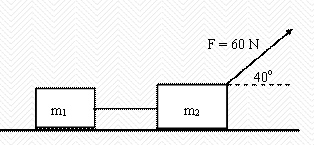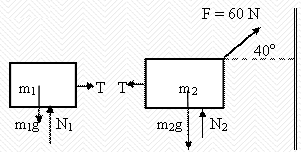Newton's 2nd law
Problem:
Two masses (m1 = 15 kg and m2 = 20 kg) are connected by
a massless cord and placed on a horizontal, frictionless surface. The
two-mass system is pulled to the right by a force FA = 60 N using a
cord that makes an angle of 40 degrees with the horizontal. The masses
remain on the horizontal surface. There is no vertical motion.

(a) Draw the free body diagrams for the two masses, properly labeling all
forces.
(b) What is the normal force between mass m2 and the
horizontal surface?
(c) What is the acceleration of the system?
(d)
What is the tension FT in the cord between the two masses?
Solution:
- Concepts:
Newton's laws
- Reasoning:
Newton's laws are well suited for the study of
unconstrained mechanical systems.
- Details of the calculation:
(a)

(b) Fx = 45.9 N, Fy = 38.6 N. N2 = m2g
- Fy = 157.4 N.
(c) a = Fx/(m1 + m2)
= 1.31 m/s2.
(d) FT = m1a = 19.7 N.
Problem:
A free particle with mass m is subjected to a
time-dependent force F(t) = F0 exp(-t/τ) for t > 0. F0 and
τ are constants.
(a) Find the velocity v(t) of the particle as a function of time, given that v
= 0 at time t = 0.
(b) What is the total work done on the particle by the force as t -->
infinity?
Solution:
- Concepts:
Newton's 2nd law, the work-kinetic energy theorem
- Reasoning:
Given the acceleration and v(0) we can find v(t) and the kinetic energy
at time t. The net work done on the object is equal to the change in the
kinetic energy of the object.
- Details of the calculation:
(a) F = ma = mdv/dt = F0 exp(-t/τ), v(t)
= (F0τ/m)(1 - exp(-t/τ)).
(b) As t -->
infinity, v --> F0τ/m.
Total work done by the force:
W = ½mvinf2
= ½(F0τ)2/m.
A 36 g bullet with a speed of 350 m/s strikes a 8 cm thick
fence post. The bullet is retarded by an average force of 3.6*103 N
while traveling all the way through the board.
(a) What speed does the bullet have when it emerges?
(b)
How many such boards could the bullet penetrate?

